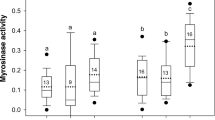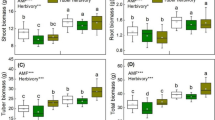Abstract
Virtually all plants employ direct and indirect defenses against herbivores. While it is known that plant defenses can be affected by belowground symbiotic microbes under controlled conditions, studies showing these multitrophic interactions in nature are surprisingly scarce. Here we tested for effects of rhizobia on insect attraction and direct defense (cyanogenesis) in wild lima bean (Phaseolus lunatus) plants in Costa Rica. We performed bioassays with rhizobia-inoculated (R+) and rhizobia-free (R-) potted plants distributed among native lima bean communities at two spatially separated field sites (450 km apart) and in two field seasons. Without affecting overall plant size, rhizobia altered leaf chemistry (cyanogenesis and soluble leaf nitrogen) and ultimately insect communities visiting the plants. Natural herbivorous chrysomelid beetles were strongly attracted to R + plants, while natural enemies, ants and parasitoid wasps, preferred R- plants resulting in a particularly high herbivore:carnivore ratio on R + plants. This suggests that symbiotic microbes mediate trophic interactions by influencing both direct and indirect plant defenses against herbivores. Our results show that rhizobia affect the plant defensive phenotype and have cascading effects on plant-insect interactions in nature.



Similar content being viewed by others
Data Availability
Data are available at https://github.com/agodschalx/MSdata2023.
References
Arimura GI, Matsui K, Takabayashi J (2009) Chemical and molecular ecology of herbivore-induced plant volatiles: proximate factors and their ultimate functions. Plant Cell Physiol 50:911–923. https://doi.org/10.1093/pcp/pcp030
Ballhorn DJ, Elias JD, Balkan MA et al (2017) Colonization by nitrogen-fixing Frankia bacteria causes short-term increases in herbivore susceptibility in red alder (Alnus rubra) seedlings. Oecologia 184:497–506. https://doi.org/10.1007/s00442-017-3888-2
Ballhorn DJ, Godschalx AL, Kautz S (2013a) Co-Variation of Chemical and Mechanical Defenses in Lima Bean (Phaseolus lunatus L). J Chem Ecol 39. https://doi.org/10.1007/s10886-013-0255-6
Ballhorn DJ, Kautz S, Heil M (2013b) Distance and sex determine host plant choice by Herbivorous Beetles. PLoS One 8. https://doi.org/10.1371/journal.pone.0055602
Ballhorn DJ, Kautz S, Schädler M (2013c) Induced plant defense via volatile production is dependent on rhizobial symbiosis. Oecologia 172:833–846. https://doi.org/10.1007/s00442-012-2539-x
Ballhorn DJ, Heil M, Lieberei R (2006) Phenotypic plasticity of cyanogenesis in lima bean Phaseolus lunatus - activity and activation of β-glucosidase. J Chem Ecol 32:261–275. https://doi.org/10.1007/s10886-005-9001-z
Ballhorn DJ, Kautz S, Lieberei R (2010) Comparing responses of generalist and specialist herbivores to various cyanogenic plant features. Entomol Exp Appl 134:245–259. https://doi.org/10.1111/j.1570-7458.2009.00961.x
Ballhorn DJ, Kautz S, Lion U, Heil M (2008) Trade-offs between direct and indirect defences of lima bean (Phaseolus lunatus). J Ecol 96:971–980. https://doi.org/10.1111/j.1365-2745.2008.01404.x
Ballhorn DJ, Kautz S, Rakotoarivelo FP (2009) Quantitative variability of cyanogenesis in cathariostachys madagascariensis - the main food plant of bamboo lemurs in Southeastern Madagascar. Am J Primatol 71:305–315. https://doi.org/10.1002/ajp.20653
Ballhorn DJ, Lieberei R, Ganzhorn JU (2005) Plant cyanogenesis of Phaseolus lunatus and its relevance for herbivore-plant interaction: the importance of quantitative data. J Chem Ecol 31:1445–1473. https://doi.org/10.1007/s10886-005-5791-2
Ballhorn DJ, Younginger BS, Kautz S (2014) An aboveground pathogen inhibits belowground rhizobia and arbuscular mycorrhizal fungi in Phaseolus vulgaris. BMC Plant Biol 14:1–13. https://doi.org/10.1186/s12870-014-0321-4
Bonaventure G (2012) Perception of insect feeding by plants. Plant Biol 14:872–880. https://doi.org/10.1111/j.1438-8677.2012.00650.x
Bradford MM (1976) A rapid and sensitive method for the quantitation of microgram quantities of protein utilizing the principle of protein-dye binding. Anal Biochem 72:248–254. https://doi.org/10.1016/0003-2697(76)90527-3
Christensen SA, Nemchenko A, Borrego E et al (2013) The maize lipoxygenase, ZmLOX10, mediates green leaf volatile, jasmonate and herbivore-induced plant volatile production for defense against insect attack. Plant J 74:59–73. https://doi.org/10.1111/tpj.12101
De Moraes CM, Lewis WJ, Pare PW et al (1998) Herbivore-infested plants selectively attract parasitoids. Nature 393:570–573. https://doi.org/10.1038/31219
Dean JM, Mescher MC, De Moraes CM (2014) Plant dependence on rhizobia for nitrogen influences induced plant defenses and herbivore performance. Int J Mol Sci 15:1466–1480. https://doi.org/10.3390/ijms15011466
Dehling DM, Bender IMA, Blendinger PG et al (2021) Specialists and generalists fulfil important and complementary functional roles in ecological processes. Funct Ecol 35:1810–1821. https://doi.org/10.1111/1365-2435.13815/SUPPINFO
Dove R, Wolfe ER, Stewart NU, Ballhorn DJ (2020) Ecoregion—rather than sympatric legumes—influences symbiotic Bradyrhizobium associations in invasive Scotch Broom (Cytisus scoparius) in the Pacific Northwest. 94:142–159. https://doi.org/10.3955/046.094.0205
Fowler SV, Macgarvin M (1985) The impact of hairy wood ants, Formica lugubris, on the guild structure of herbivorous insects on birch, Betula pubescens. J Anim Ecol 54:847–855
Godschalx AL, Schädler M, Trisel JA et al (2015) Ants are less attracted to the extrafloral nectar of plants with symbiotic, nitrogen-fixing rhizobia. Ecology 96:348–354. https://doi.org/10.1890/14-1178.1
Godschalx AL, Tran VY, Ballhorn DJ (2017) Host plant cyanotype determines degree of rhizobial symbiosis. Ecosphere 8. https://doi.org/10.1002/ecs2.1929
Goulet H, Huber JT (eds) (1993) Hymenoptera of the world: an identification guide to families. Canada Communication Group Publishing, Ottowa, Canada
Hanson P, Gauld ID (eds) (1995) The Hymenoptera of Costa Rica. Oxford University Press, p 893
Hempel S, Stein C, Unsicker SB et al (2009) Specific bottom–up effects of arbuscular mycorrhizal fungi across a plant–herbivore–parasitoid system. Oecologia 160:267–277. https://doi.org/10.1007/s00442-009-1294-0
Hoballah FEM, Turlings TCJ (2001) Experimental evidence that plants under caterpillar attack may benefit from attracting parasitoids caterpillar attack may benefit from attracting parasitoids. Evol Ecol Res 3:553–565
Irmer S, Podzun N, Langel D et al (2015) New aspect of plant–rhizobia interaction: alkaloid biosynthesis in Crotalaria depends on nodulation. Proc Natl Acad Sci 112:4164–4169. https://doi.org/10.1073/pnas.1423457112
Kaschuk G, Kuyper TW, Leffelaar PA et al (2009) Are the rates of photosynthesis stimulated by the carbon sink strength of rhizobial and arbuscular mycorrhizal symbioses? Soil Biol Biochem 41:1233–1244. https://doi.org/10.1016/j.soilbio.2009.03.005
Kempel A, Brandl R, Schädler M (2009) Symbiotic soil microorganisms as players in aboveground plant-herbivore interactions - the role of rhizobia. Oikos 118:634–640. https://doi.org/10.1111/j.1600-0706.2009.17418.x
Kiers ET, Rousseau RA, Denison RF (2006) Measured sanctions: legume hosts detect quantitative variation in rhizobium cooperation and punish accordingly. Evol Ecol Res 8:1077–1086
Kost C, Heil M (2008) The defensive role of volatile emission and extrafloral nectar secretion for lima bean in nature. J Chem Ecol 34:2–13. https://doi.org/10.1007/s10886-007-9404-0
Letourneau DK, Jedlicka JA, Bothwell SG, Moreno CR (2009) Effects of natural enemy biodiversity on the suppression of arthropod herbivores in terrestrial ecosystems. Annu Rev Ecol Evol Syst 40:573–592. https://doi.org/10.1146/annurev.ecolsys.110308.120320
Murdoch WW, Chesson J, Chesson PL (1985) Biological control in theory and practice. Am Nat 125:344–366
Pangesti N, Weldegergis BT, Dicke M, Pineda A (2015a) Rhizobacterial colonization of roots modulates plant volatile emission and enhances the attraction of a parasitoid wasp to host – infested plants. Oecologia 1169–1180. https://doi.org/10.1007/s00442-015-3277-7
Pangesti N, Weldegergis BT, Langendorf B et al (2015b) Rhizobacterial colonization of roots modulates plant volatile emission and enhances the attraction of a parasitoid wasp to host-infested plants. Oecologia 1169–1180. https://doi.org/10.1007/s00442-015-3277-7
Paré PW, Tumlinson JH (1999) Plant volatiles as a defense against insect herbivores. Plant Physiol 121:325–331
Peoples MB, Pate JS, Atkins CA, Bergersen FJ (1986) Nitrogen nutrition and xylem sap composition of peanut (Arachis hypogaea L. cv Virginia bunch). Plant Physiol 82:946–951
Pineda A, Soler R, Weldegergis BT et al (2013) Non-pathogenic rhizobacteria interfere with the attraction of parasitoids to aphid-induced plant volatiles via jasmonic acid signalling. Plant Cell Environ 36:393–404. https://doi.org/10.1111/j.1365-3040.2012.02581.x
Pringle EG (2016) Integrating plant carbon dynamics with mutualism ecology. New Phytol 210:71–75. https://doi.org/10.1111/nph.13679
R Core Team (2018) R: a language and environment for statistical computing. R Foundation for Statistical Computing, Vienna. https://www.R-project.org
Radhika V, Kost C, Mithofer A, Boland W (2010) Regulation of extrafloral nectar secretion by jasmonates in lima bean is light dependent. Proc Natl Acad Sci 107:17228–17233. https://doi.org/10.1073/pnas.1009007107
Rasmann S, Köllner T, Degenhardt J et al (2005) Recruitement of entomopathogenic nematodes by insect-damaged maize roots. Nature 434:732–737. https://doi.org/10.1038/nature03451
Röse USR, Lewis J, Tumlinson JH (2006) Extrafloral nectar from cotton (Gossypium hirsutum) as a food source for parasitic wasps. Funct Ecol 20:67–74. https://doi.org/10.1111/j.1365-2435.2006.01071.x
Summers M, Mondor E (2011) Rhizobium alters inducible defenses in broad bean, Vicia faba. Open J Ecol 1:57–62. https://doi.org/10.4236/oje.2011.13007
Tan XL, Liu TX (2014) Aphid-induced plant volatiles affect the attractiveness of tomato plants to Bemisia tabaci and associated natural enemies. Entomol Exp Appl 151:259–269. https://doi.org/10.1111/eea.12190
Thaler JS (1999) Jasmonate-inducible plant defences cause increased parasitism of herbivores. Nature 399:686–688. https://doi.org/10.1038/21420
Thamer S, Schädler M, Bonte D, Ballhorn DJ (2011) Dual benefit from a belowground symbiosis: Nitrogen fixing rhizobia promote growth and defense against a specialist herbivore in a cyanogenic plant. Plant Soil 341:209–219. https://doi.org/10.1007/s11104-010-0635-4
Trinick M, Hadobas P (1990) Symbiotic effectiveness of Bradyrhizobium strains isolated from Parasponia and tropical legumes on Parasponia host species. Plant Soil 124:117–126
Turlings TCJ, Tumlinson JH, Lewis WJ (1990) Exploitation of herbivore-induced plant odors by host-seeking parasitic wasps. Science (80-) 250:1251–1253
Turlings TCJ, Wäckers F (2004) Recruitment of predators and parasitoids by herbivore-injured plants. Adv Isect Chem Ecol 2:21–75. https://doi.org/10.1017/CBO9780511542664.003
Turlings TCJ, Wäckers FL, Vet LEM et al (1993) Learning of host-finding cues by Hymenopterous parasitoids. Insect Learn Ecol Evol Perspect 3:51–78. https://doi.org/10.1017/CBO9781107415324.004
Winter TR, Rostás M (2010) Nitrogen deficiency affects bottom-up cascade without disrupting indirect plant defense. J Chem Ecol 36:642–651. https://doi.org/10.1007/s10886-010-9797-z
Acknowledgements
Funding by the National Science Foundation (NSF) to DJB (grants IOS 1457369, 1656057) and ALG (Fellow ID: 2014159631) is gratefully acknowledged.
Funding
Funding by the National Science Foundation (NSF) to D.J.B. (grants IOS 1457369 and 1656057) and A.L.G. (1501420).
Author information
Authors and Affiliations
Contributions
A.L.G., D.B., and S.K. designed and carried out the experiment. A.D. and A.L.G. processed and analyzed data and created final figures. A.L.G wrote the main manuscript text. All authors reviewed and participated in revising the manuscript.
Corresponding author
Ethics declarations
Competing Interests
The authors declare no competing interests.
Conflict of Interest
The authors declare that they have no conflicts of interest.
Additional information
Publisher’s Note
Springer Nature remains neutral with regard to jurisdictional claims in published maps and institutional affiliations.
Rights and permissions
Springer Nature or its licensor (e.g. a society or other partner) holds exclusive rights to this article under a publishing agreement with the author(s) or other rightsholder(s); author self-archiving of the accepted manuscript version of this article is solely governed by the terms of such publishing agreement and applicable law.
About this article
Cite this article
Godschalx, A.L., Diethelm, A.C., Kautz, S. et al. Nitrogen-Fixing Rhizobia Affect Multitrophic Interactions in the Field. J Insect Behav 36, 168–179 (2023). https://doi.org/10.1007/s10905-023-09833-8
Received:
Revised:
Accepted:
Published:
Issue Date:
DOI: https://doi.org/10.1007/s10905-023-09833-8




